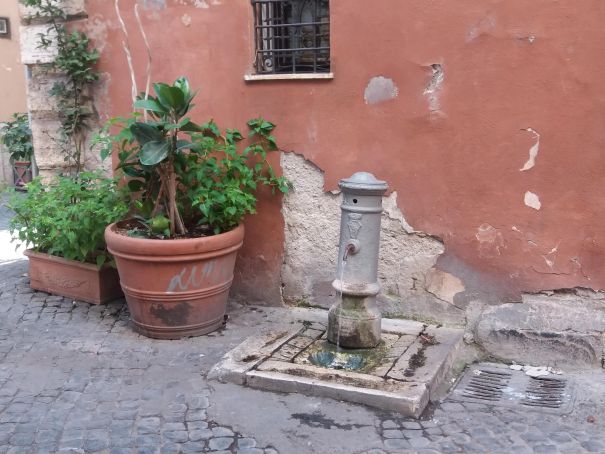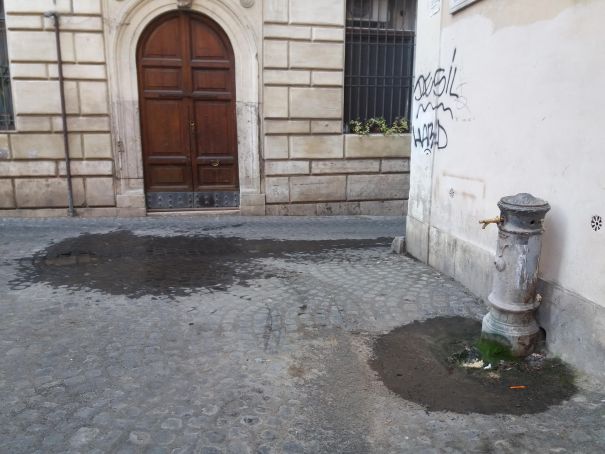By Mary Wilsey.
Rome was threatened with water rationing at the end of July but political bickering and mismanagement are as much a problem as the shortage of water itself.
Roma, Regina Aquarum are the words that jump out at you when you look at the website of Rome's water supplier, ACEA. Rome, Queen of Water might once have been a suitable epithet to describe the city but not in the summer of 2017. A city that still prides itself of its ancient Roman aqueducts and its renaissance fountains has demonstrated that it is less capable today of managing its water resources that it was two millennia ago.
Admittedly it has been a hot and dry summer. Lack of rain throughout the winter has left many of the lakes around the city at dangerously low levels. But this is only part of the story. Underinvestment in infrastructure, political bickering and lack of planning tell the rest of the tale.
At the end of July ACEA threatened to ration water in Rome to eight hours a day. It is possible that the utility company was just highlighting a serious problem in the most dramatic way it could, but the threat was there. At the same time the governor of the Lazio region, Nicola Zingaretti, announced that he would prevent water being fed from Lake Bracciano, north of the city, into Rome's system. Given the perilously low level of the lake and the ecological threat this poses to the surrounding area, his action looked justified. The danger to Rome was averted only at the last moment when the ministry of the environment stepped in on the grounds that turning off water supplies would be detrimental to public health and tourism.
The city's mayor, Virginia Raggi, claimed the credit for preventing the city from running dry, and throughout the rest of the summer most of the fountains sparkled on (except those in the Vatican, which were turned off in a gesture of goodwill to the city) and the 19th-century cast-iron water dispensers, or nasoni, continued to trickle.
If there was ever a cost-effective and public-spirited way of supplying water in Rome it must have been the installation of nasoni throughout the city at the turn of the 20th century.
Those were the days of lavish public works and monumental projects to celebrate the unification of Italy. The courts of justice, the Bank of Italy, the new state's various ministries in the Via Nazionale area and of course the Altare della Patria which towers over Piazza Venezia are the most obvious examples of the building spree. But rather than build lavish fountains like the papal rulers they replaced, the architects of the new Italy decided to go for street-level water dispensers as the best way to ensure that the inhabitants of the rapidly expanding city had plentiful and clean drinking water at a time when running water in houses was still not widely available.

These were a much less grandiose answer to the ancient Roman aqueducts and much less flamboyant than the renaissance and baroque fountains the popes commissioned to enhance their prestige. Sturdy, stubby and totally utilitarian, they appeared all over the city. Their one extravagance was that they provided a constant flow of water from the outlet (or nasone, which gave the drinking fountains their name) into the little run-off hole in the ground.
Some of the original models, especially around the Vatican, have now been fitted with pressure taps to regulate the flow of water, but there are still many where the water flows non-stop.
Surprisingly they remain a vital part of the city's services. They supply tourists with free water; they provide washing facilities for the ever-growing number of homeless; they are still used by stall holders in the dwindling street markets to wash fruit and vegetables.
Cutting off their supply this summer would have been one way of bringing public attention to the water shortage in the city, but it was more a shock tactic than a solution to the real problem. Closing the nasoni is about as effective as not washing teeth or hands under running water; it is a feel-good reminder that water is a precious resource but the saving is minimal.
Although cutting off water from Lake Bracciano led to alarmist headlines it would have been inconvenient rather than decisive for Rome; the lake supplies only about three per cent of the city's water. By far the largest part, about 85 per cent, comes from springs in the province of Rieti along the Peschiera aqueduct. The remainder is supplied mainly from wells around the city.
The Peschiera aqueduct is not part of the ancient Roman system, some of which is still used, but was first contemplated and then designed in the early 20th century at the time of the post-unification building boom in the new capital. Construction did not begin until 1937 and was then suspended at the outbreak of world war two. Work on it did not start again until the end of hostilities and then trickled on until it was finally completed in the 1980s.
Luckily for Rome water along the Peschiera is still abundant thanks to the heavier than usual snow falls in the Apennines last winter.
Mount Nuria, which feeds the Peschiera, is southeast of Rieti close to Cittaducale, bordering the Abruzzo. It is one of the largest springs of drinkable water in Italy and most unusually its water is so pure that it does not have to be treated. It is joined at Salisano north of Castelnouvo di Farfa by water from various basins, called Le Capore. The hydroelectric power station built at Salisano also provides electricity for Rome. Most of the aqueduct's 130 kms are underground, which is perhaps why it is not as well known as its majestic-looking ancient Roman equivalents. Nor does its final fountain in Rome, in Piazzale degli Eroi, have a fraction of the pull of either the Trevi (fed by Acqua Vergine) or the Fontanone (fed by Acqua Paola).
The Peschiera-Capore aqueduct is about as utilitarian as Rome's nasoni, which are in fact mainly supplied by the Peschiera. But it is the city's life line and although it is not threatened by drought – at least not yet – it runs through earthquake territory and the recent devastating seismic upheavals along the central Apennines must have given ACEA engineers some sleepless nights.
Maintenance is in fact one of the major problems for almost all of Italy's water utilities. It is estimated that in some areas, particularly in the south, water seepage from leaking pipes means that over 40 per cent of water runs to waste. The problem is not quite as acute in Rome but maintenance is difficult especially in the historic centre. Not far from Piazza Navona, home of Bernini's magnificent Four Rivers Fountain commissioned by Pope Innocent X in 1651, there is a narrow street with a permanent wet patch next to a nasone with a malfunctioning pressure tap that could be quickly fixed. But the permanent puddle has been there all summer, seeping from some underground hole. Only a few months ago the street was closed for maintenance to a gas pipe (or was it electricity cables or telecommunication fibre optics?) and the sampietrini, or cobblestones, have only just been replaced. The water maintenance crews are unlikely to return for a while.

Maintenance would be easy enough given sufficient money, political will and organisation ability. However, water rights are a far more serious difficulty. The codice civile, Italy's civil code, has whole sections dedicated to water rights, as indeed did the ancient Roman codes on aqueducts. But today who should pay what price for the water flowing through the Peschiera aqueduct has been argued back and forth since the last agreement came to an end in 1996.
In theory the city of Rome, as the major shareholder of ACEA, should pay water dues to the province of Rieti for drawing water out of its mountains. But who decides how much it should pay? Lazio's governor Zingaretti, of the Partito Democratico, managed to negotiate an agreement last year for an annual payment plus a one-time sum to cover the arrears since the last contract ended. However Rome's mayor, from the Movimento 5 Stelle, says the city won't pay. And so the stalemate continues.
Playing political games with water is akin to playing with fire. Rationing domestic supplies may lose votes but in the end it is more an annoyance than a hardship. It is always possible to fill up the bathtub and buckets and wait until the water returns. But cutting off water to industry, agriculture and the construction sectors would have a potentially devastating effect. Anyone who has watched a block of flats go up will know how much water is needed in its construction. Even the ancient Romans knew this. The Roman aqueducts were not constructed just to provide the wealthier citizens with their hot baths and the poorer ones with uncontaminated water. The abundance of water then, just as now, was fundamental to the economic growth and power of the city. If Mayor Raggi won't pay the city's water bills today and if, just if, Rieti, hard hit by the financial damage done by last year's earthquake, turned off the taps of the Peschiera, Rome's economy would be in as great danger of decline as its citizens would be of going thirsty.
Water referendum 2011
In two referendums on the supply and the cost of water in June 2011 Italians voted overwhelmingly that supply and distribution should be managed by public authorities rather than private interests and that the price consumers pay for water should not reflect the real cost of investment to suppliers.
While Italians clearly believe that water supply should be a public service, central, regional and local authorities as well as the suppliers themselves are still wondering how best to pay for the service and encourage investment in badly maintained infrastructure and remodernisation.
New amendments to old laws have been put forward, regulations have been drawn up and various courts have had their say. In the six years since the referendum the overlapping jurisdictions between central, regional and local authorities, combined with a number of conflicting court rulings, have proved that a clearly defined policy on water is almost impossible.
The complex situation is not helped by the fact that not all households have water metres, the historic centre of Rome being a case in point. In such cases payment according to consumption – regardless of who supplies the water and whether it is subsidised or at a market price – is not feasible anyway.


















